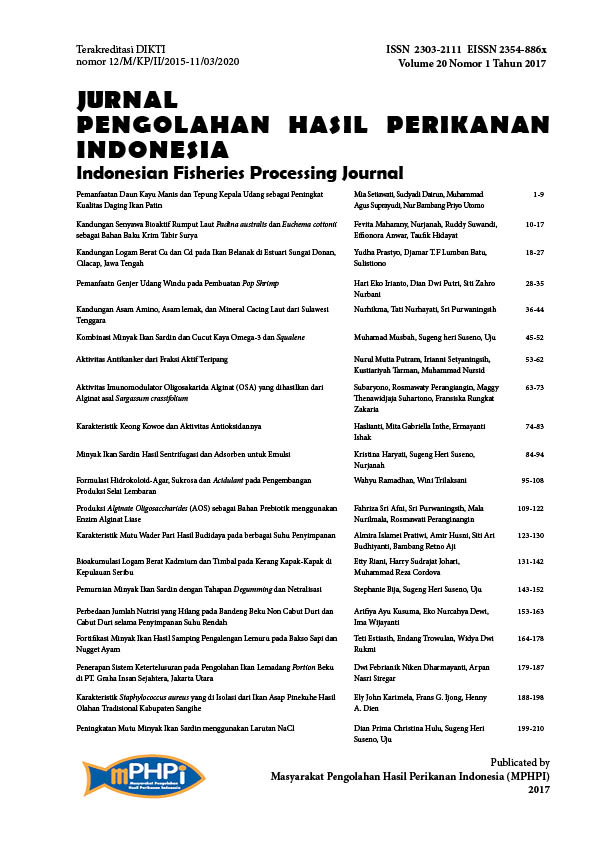Formulation of Hydrocolloid-Agar, Sucrose, and Acidulant on Jam Leather Product Development
Abstract
Tallying agar powder as a texturizer in guava single sheet jam instigate the product more convenience to consumed. The aims of this research were to determine the best concentration of sucrose, citric acid and agar powder to form a good quality guava jam slice. The research method are optimization and formulation
of sucrose, citric acid and agar-agar on making guava jam single sheets product. Physochemical and sensory tests were performed to reveal the best formulation of guava jam slice and the Bayes method used to determine the optimization of the selected formula. Based on the results of formulation and analysis, it
was obtained that the guava jam slice with Acidulant concentration (0.02%, 0.04%, 0.06%), sucrose (70%, 80%, 90%, 100%) and agar powder (0.7%, 0.8%, 0.9%, 1.0%, 1.1%, 1.2%) had pH 3.63-3.90, sugar content 34.68 g/100 g – 35.76 g/100 g, color intensity L*, a*, b* with ΔE* value was 37,88-53,97, fiber content 1.01%-1.59%, and water activity 0.852-0.893. Rheology properties for texture profile (hardness, cohesiveness, springiness, adhesive force, and gumminess) also showed significant value with agar powder formulation. Based on the Bayes test and hedonic test, it was found that the best formula was for guava jam slices with the addition of 90% sucrose, citric acid 0.04% and agar powder 0.9%. From the best formula, it was found the shelf life prediction model of Arrhenius formula was ln k = 20.222-6660.6(1/T) and the nutrition facts contribute total energy 45 kcal, fat 0%, carbohydrate 9%, protein 2% and dietary fiber 3%.
of sucrose, citric acid and agar-agar on making guava jam single sheets product. Physochemical and sensory tests were performed to reveal the best formulation of guava jam slice and the Bayes method used to determine the optimization of the selected formula. Based on the results of formulation and analysis, it
was obtained that the guava jam slice with Acidulant concentration (0.02%, 0.04%, 0.06%), sucrose (70%, 80%, 90%, 100%) and agar powder (0.7%, 0.8%, 0.9%, 1.0%, 1.1%, 1.2%) had pH 3.63-3.90, sugar content 34.68 g/100 g – 35.76 g/100 g, color intensity L*, a*, b* with ΔE* value was 37,88-53,97, fiber content 1.01%-1.59%, and water activity 0.852-0.893. Rheology properties for texture profile (hardness, cohesiveness, springiness, adhesive force, and gumminess) also showed significant value with agar powder formulation. Based on the Bayes test and hedonic test, it was found that the best formula was for guava jam slices with the addition of 90% sucrose, citric acid 0.04% and agar powder 0.9%. From the best formula, it was found the shelf life prediction model of Arrhenius formula was ln k = 20.222-6660.6(1/T) and the nutrition facts contribute total energy 45 kcal, fat 0%, carbohydrate 9%, protein 2% and dietary fiber 3%.
Authors
RamadhanW., & TrilaksaniW. (2017). Formulation of Hydrocolloid-Agar, Sucrose, and Acidulant on Jam Leather Product Development. Jurnal Pengolahan Hasil Perikanan Indonesia, 20(1), 95-108. https://doi.org/10.17844/jphpi.v20i1.16495
Authors who publish with this journal agree to the following terms:
- Authors retain copyright and grant the journal right of first publication with the work simultaneously licensed under a Creative Commons Attribution License that allows others to share the work with an acknowledgement of the work's authorship and initial publication in this journal.
- Authors are able to enter into separate, additional contractual arrangements for the non-exclusive distribution of the journal's published version of the work (e.g., post it to an institutional repository or publish it in a book), with an acknowledgement of its initial publication in this journal.





